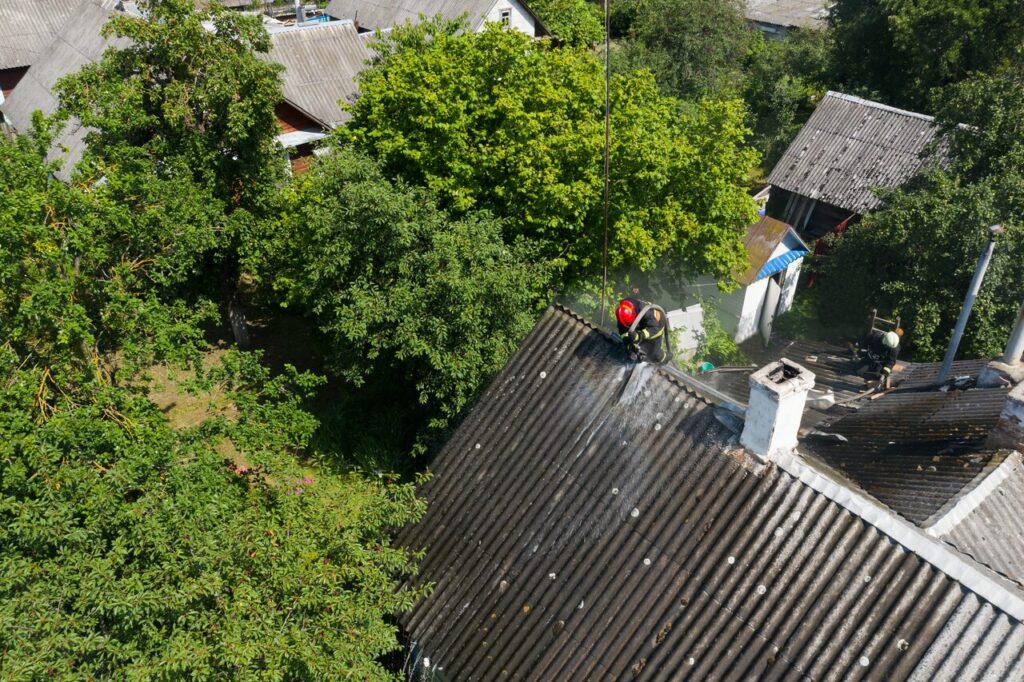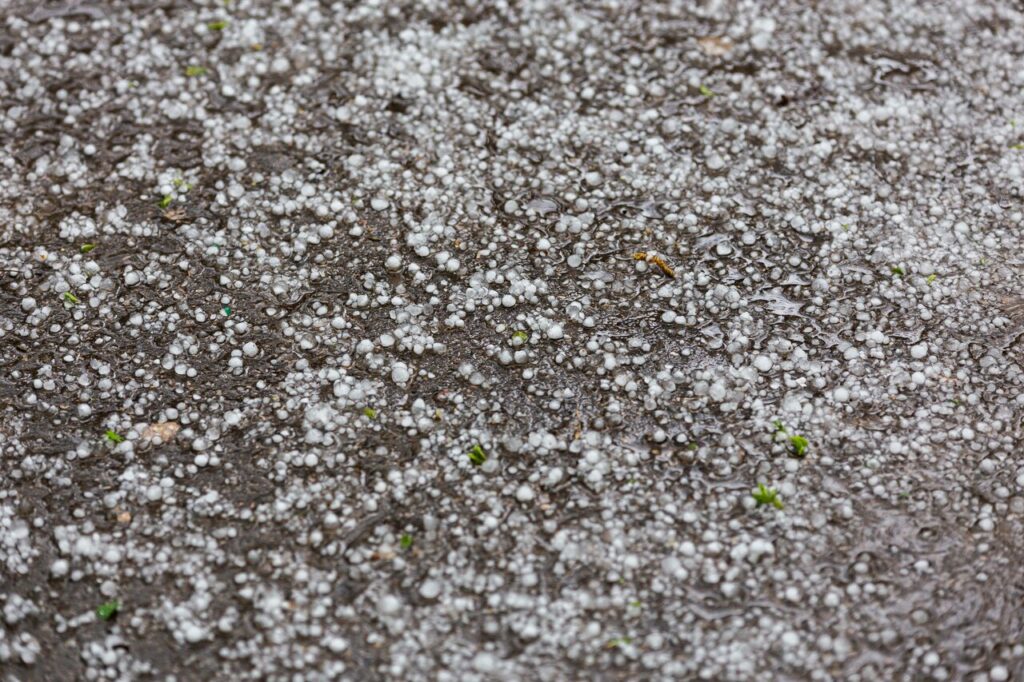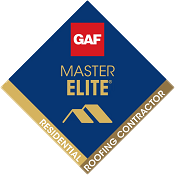Homeowners in some parts of the country must deal with hail and the potential damage it can cause to property, especially roofs. In fact, hail storm roof damage is one of the more common issues that roofers have to deal with in the United States.
What Is Hail?
Hail is a form of solid precipitation that falls from the sky during thunderstorms. It consists of balls or irregular lumps of ice that form when upward air currents carry raindrops into the upper level of clouds. There, the cold temperatures turn the raindrops into ice particles.
As the ice particles drop back through the warmer parts of the cloud, they pick up more moisture and get caught in another updraft. As this process gets repeated, hail stones continue to grow in size, until they get so large that they can no longer remain airborne and fall to the ground.
Individual hail stones can range in size from peanuts to softballs.
What Parts of the Country Get Hail?
Hail storms can occur anywhere in the United States; however, they are most common in the central plains states, such as Colorado, Nebraska, and Wyoming. Hail is also commonly seen in the Midwest and Southeast regions of the country.
Although hail can fall during any season, hail storms are most common in the spring and summer months.
In 2020, the National Oceanic and Atmospheric Association recorded over 4,600 large hail storms.
How Much Damage Does Hail Do to Roofs Around the Country?
It has been estimated that hail causes an estimated $8 billion in property damage per year across the United States. (This figure includes damage to both homes and vehicles.) Hail damage is one of the most common types of insurance claims, and it is estimated that hail storms cause approximately $1 billion in damage each year to roofs alone.
The amount and extent of roof damage from a hail storm depends on a variety of factors, including the roofing material and the size of the hail stones. While some smaller hail stones are the size of a pea (¼ inch in diameter), large stones can be the size of baseballs (2¾ inches) or even softballs (4 inches). In 2019, a hailstorm in Bethune, Colorado dropped a hailstone that was 4.83 inches in diameter!
Impact tests have shown that hail stones that are one inch in diameter can damage 3-tab organic asphalt shingles. Cedar shingles, 3-tab fiberglass asphalt shingles, fiber-cement tiles, and flat concrete tiles are likely to be damaged by slightly larger hailstones – 1¼ inches. Heavy cedar shakes, 30-year laminated shingles, built-up gravel roofing, and S-shaped concrete tiles will all be vulnerable to damage if the stones are 1½ to 2 inches in diameter.

What Are Signs of Hail Damage On a Roof?
There are several signs that hail may have damaged a roof.
Impact Marks
One of the most obvious signs is hailstone impact marks on the shingles or other roofing materials. These marks will appear as small, round indentations in the surface of the shingle.
Missing Granules on Asphalt Shingles
Another sign of hail damage is granules missing from asphalt shingles. As hail hits the shingles, it can dislodge the protective granules, leaving the bare asphalt exposed. This can lead to premature aging of the shingles and make them more susceptible to wind and rain damage.
Dented Gutters, Downspouts, or Siding
If a hail storm was strong enough to damage a roof, it likely caused damage to other parts of the home’s exterior, including gutters, downspouts, and siding.
Air Conditioners, Decks, and Other Outdoor Items
Anything outdoors can sustain damage from hail, and problems elsewhere could suggest that the roof might also need to be inspected for damage.
Roof Vents, Skylights, and Chimney Covers
Roof vents and other features on the roof can be damaged by hail, even if the roofing material itself has not been impacted by the storm.
Hail Damage and Different Roofing Materials
If you live in an area that is prone to hail storms, it is important to know how hail damage can affect your roof. Hail stones can range in size from small pebbles to large chunks of ice, and when they hit your roof they can cause serious damage.
There are three main types of hail damage: bruising, crushing, and stripping:
- Bruising occurs when hailstones hit the shingles hard enough to break through the granules on the surface but not hard enough to penetrate the underlying asphalt. This type of hail damage is usually not visible from the ground.
- Crushing occurs when hailstones hit the shingles hard enough to penetrate the underlying asphalt. This type of hail damage is usually visible from the ground as dimples or depressions in the shingles.
- Stripping occurs when hailstones hit the shingles hard enough to remove the granules on the surface. This type of hail damage is usually visible from the ground as bare spots on the shingles.
Hail damage can manifest itself in a number of ways, depending on the type of roofing material you have. Here are some signs to look for:
Asphalt Shingles
Shingles are the most common type of roofing material, and they are also the most vulnerable to hail damage. Hail stones can cause granules to loosen and fall off, or they can crack or break the shingles themselves.
Missing granules can be difficult for an untrained person to spot, so it is advisable to have a professional roofing company inspect your roof for damage after a hail storm.
Metal Roofing
Metal roofing is much more resistant to hail damage than shingles, but it is not immune. Hail can dent or ding the metal, and over time this can lead to rust and leaks. If you see any dents in your metal roof, it is a good idea to have a professional assess whether the hail damage needs to be repaired or if it is just cosmetic.
Tile Roofing
Tile roofs are very durable, but hail can still cause damage. Hail stones can crack or break tiles, and if enough tiles are damaged it can weaken the entire roof. If you see any cracked or broken tiles, it is important to have a professional inspect your roof for hail damage.

What Should a Homeowner Do If They Have Hail Damage?
If hail has damaged your roof, it is important to have a professional roofing contractor inspect the damage and make any necessary repairs. Hail damage to your roof can worsen over time, and if left unaddressed it can lead to serious problems like leaks and structural damage.
A professional roofer will be able to determine the extent of the damage and recommend the best course of action for repairs. They will also be able to recommend any preventive measures you can take to reduce the risk of hail damage in the future.
While it can be tempting to attempt hail-damage repairs on your own, it is important to know that doing so could void your roof’s warranty and may even cause further damage. Before attempting any DIY roof repair, read your manufacturer’s roofing material warranty carefully. Money saved from doing it yourself could end up costing you down the road.
Does Homeowners Insurance Cover Hail Damage?
Most hail damage is cosmetic, meaning it does not penetrate the roofing material. This type of hail damage looks like white or light-colored dimples on the shingles or other roofing material. Many homeowner’s insurance policies have an exclusion that precludes payment for damage that is only cosmetic.
If your roof does sustain hail damage that is “functional” and more than cosmetic, it is important to contact your insurance company as soon as possible to file a claim. In this case, it is posible that your insurance policy may cover the cost of roof repair or new roof installation.
Insurance companies have specific rules when it comes to what hail damage they will cover. For example, some policies state there must be eight or more hits within a 10ft x 10ft area on at least three slides of the roof. Since each policy is unique, it is important for homeowners to read their specific policy carefully to understand if the damage to their roof will be covered.
Impact-Resistant Roofing Materials
If you live in an area that is prone to hail storms, you may want to consider investing in impact-resistant roofing materials. These materials are designed to resist hail damage and can often be installed by a qualified roofing contractor.
Two companies, Underwriters Laboratories (UL) and FM Approvals, are most often used to assess roofing materials’ impact resistance.
In UL testing, steel balls of various sizes are dropped from varying heights onto freshly constructed roof coverings. Ice balls are launched onto freshly manufactured material and tested in FM Approvals.
When a piece of roofing material passes two tests without evidence of fracture, it is said to be in compliance. Shingles are classified as Class 1, 2, or 3 based on the level of protection they provide:
1) Class 1 Covers only the top layer and provides basic wind resistance. This is the minimum level of protection required by most building codes.
2) Class 2 Covers both the top layer and the underlayment, providing better wind resistance. This is the standard level of protection in most areas.
3) Class 3 Covers both the top layer and the underlayment, providing superior wind resistance. This is the highest level of protection available and is often required in hurricane-prone areas.
Here are a few of the benefits from impact-resistant roofs:
- More able to withstand impact from hail and other flying debris
- Most impact-resistant roofs are also Class A rated for fire
- Some homeowner’s policies may offer an annual discount
- Increased property value if you want to sell your home
- Reduced environmental impact since your roof should last longer
Impact-resistant roofing materials are typically more expensive, but the upfront cost may well be worth it due to the potential savings from roof repairs down the road.
Stronghold Roofing & Solar In & Near Lakeland, FL
Whether it is from hail damage, hurricanes, or falling trees, when you need roofing service contact the best roofing company in Florida – Stronghold Roofing and Solar.
Our experienced roofing technicians and our unparalleled customer service make us the choice for all your residential or commercial roofing and solar needs, including:
- Roof Repair
- Roof Maintenance
- Roof Installation
- New Construction
We offer emergency roofing services, roof financing, energy efficient solutions, and – most important of all – peace of mind.
Contact us at 863-563-3254 today for a free estimate.










